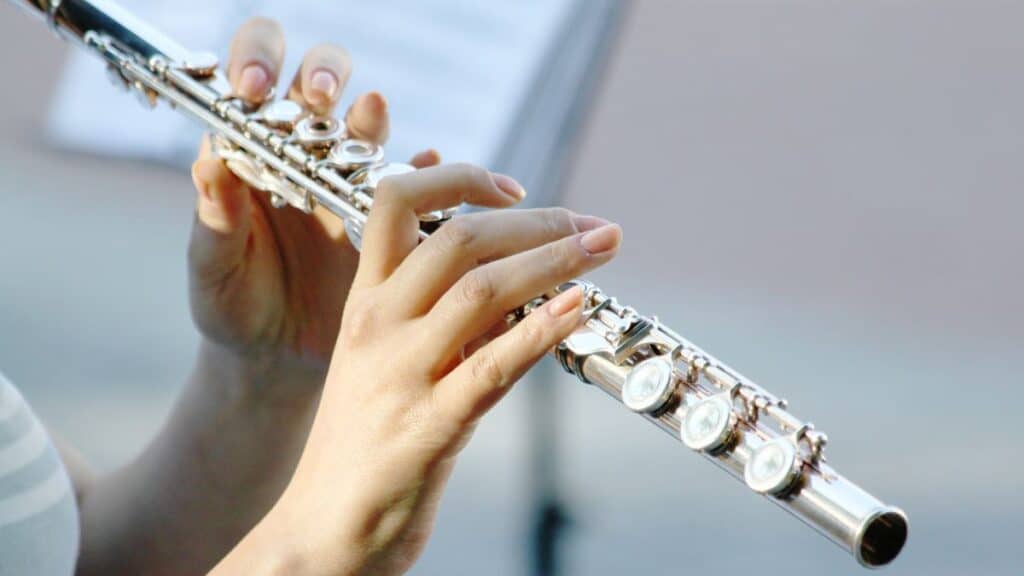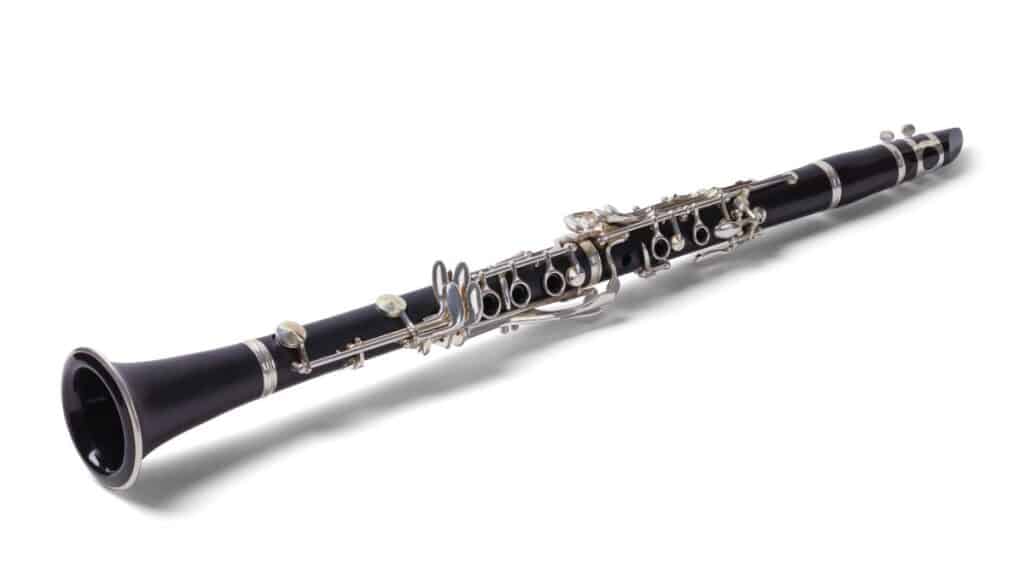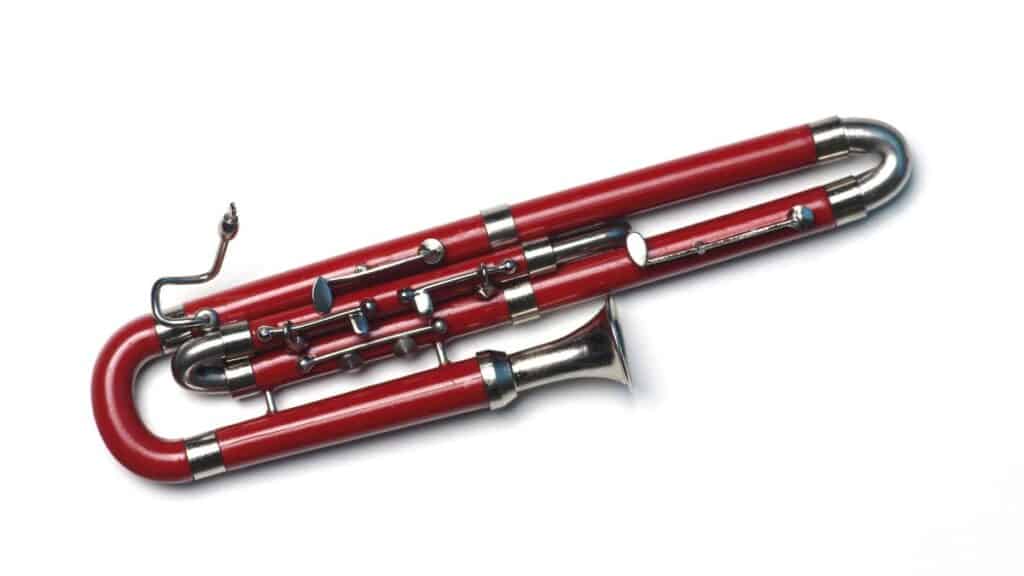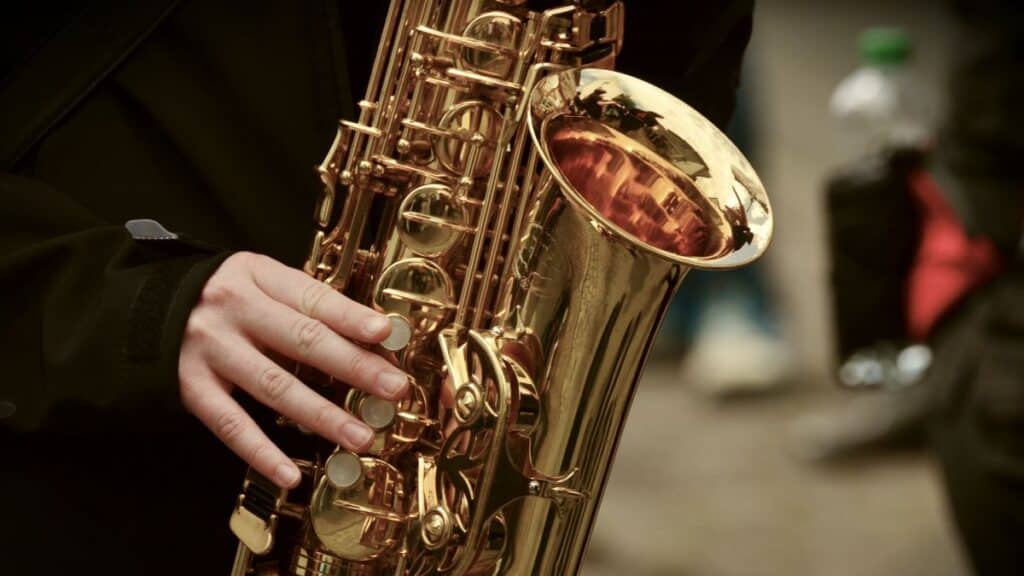Woodwind instruments are a family of musical instruments within the more general category of wind instruments.
They are so named because they were traditionally made of wood, although now they can be constructed of metal, wood, plastic, ivory, and even glass.
What sets them apart is how they produce sound: the player either blows against a sharp edge, as in flutes, or into a reed, which then vibrates to create the sound.
The woodwind family consists of many members, each with unique characteristics and tonal qualities. Some are staples in orchestral settings, while others might be more common in jazz bands or traditional folk music from around the world.
Is a Wind Instrument the same as a Woodwind Instrument?
Let’s first discuss the difference between a wind instrument and a woodwind instrument.
A wind instrument is defined as a musical instrument having a resonator (usually a tube) where sound is produced by moving vibrations made by a player blowing air into a mouthpiece or reed.
There are two types of wind instruments: Brass Instruments and Woodwind Instruments.
This is one key difference between brass and woodwind instruments.
A brass instrument is played through a mouthpiece and is exclusively made of metal or brass. Woodwind instruments, on the other hand, are played by blowing air through a reed.
We have included popular wind instrument names found in the orchestra as well as other popular musical instruments that are culturally significant. Let’s take a look at the types of woodwind instruments beginning with the flute family.
Flute Family

The flute family is one of the oldest and most widely recognized members of the woodwind family.
The flutes produce sound by directing a focused stream of air onto the edge of a hole found on the side of the instrument.
While flutes can be made from a variety of materials, their use of a non-reed mouthpiece is what sets them apart from other woodwind instruments.
The Concert Flute
The concert flute, also known simply as the flute, is the flute most people are familiar with. It is a reedless musical instrument that produces its tone by the flow of air across an opening.
Made of silver, gold, or alloys, the concert flute is a versatile instrument that can produce a beautiful, bright sound that can pierce through the texture of the orchestra or it can have a mellow, rich, and sweet tone.
A key instrument in orchestral ensembles, chamber music, and solo repertoire, the concert flute has a range extending from middle C upwards for three octaves.
Piccolo
The piccolo is the smallest member of the flute family, and also one of the highest-pitched instruments in the orchestra.
Its name comes from the Italian for “small,” but despite being about half the size of a traditional flute, the piccolo plays a big role. Its piercing tone can be heard over the sound of an entire orchestral ensemble.
Just like the concert flute, the piccolo is a reedless instrument, producing sound by blowing air across the mouthpiece.
However, the piccolo plays an octave higher than the concert flute, making its sound brighter and more shrill. It’s often used for playing quick, energetic passages and for adding brightness to the overall sound of an orchestra.
Alto Flute
The alto flute is a larger and slightly more curved member of the flute family, and it carries a beautifully mellow and rich tone.
Its tubing is longer than a concert flute, and it is usually made of silver or nickel silver. Due to its larger size, the alto flute sounds a perfect fourth below the concert flute, placing it in the key of G.
Used in orchestral music, chamber music, film scores, and jazz, the alto flute provides depth to the overall sound of a flute section. It’s particularly valued for its warm, mysterious, and haunting quality, making it ideal for emotive or atmospheric pieces.
Bass Flute
Even larger and more curved than the alto flute is the bass flute. As the name implies, the bass flute provides a lower register than the concert and alto flutes. Specifically, it sounds one octave lower than the concert flute.
This musical instrument is relatively rare due to its size and unique tonal characteristics, but when it is used, it provides a rich, dark, and resonant tone that adds depth to the lower registers of an ensemble.
The bass flute’s length requires it to be made in a “J” shape to facilitate playability. Its sound can be thought of as a blend between a standard flute and a cello — it’s a deep, soothing tone that adds a special color to the music.
Oboe Family
The oboe family encompasses a variety of double-reed woodwind instruments known for their vibrant, penetrating sound – featuring metal keys covering the holes.
Oboes distinguish themselves from other woodwind instruments with their unique timbre and the use of a double reed, giving them a characteristic tone that’s both poignant and expressive. These instruments are often used in orchestras, concert bands, and chamber music ensembles.
Concert Oboe
The concert oboe, more commonly known simply as the “oboe,” is a soprano-range double-reed instrument recognized by its bright, clear, and slightly nasal tone.
It’s usually made from grenadilla or rosewood, but can also be made from synthetic materials. Known for its hauntingly beautiful sound, the concert oboe often plays the main melody in orchestral pieces, with a range extending from the Bb below middle C to around the A6, or even up to C7 for very skilled players.
Cor Anglais (English Horn)
The Cor Anglais, also referred to as the English Horn, is the alto or tenor member of the oboe family. Slightly larger and lower in pitch than the concert oboe, the Cor Anglais is known for its distinctive rounded bell shape and bent metal crook to which the reed is attached.
The instrument produces sound more mellow and full-bodied compared to the soprano oboe. Despite its name, the Cor Anglais is neither English nor a horn, and its music is often written to evoke feelings of nostalgia or melancholy.
Oboe d’Amore
The Oboe d’Amore, translating to “oboe of love,” is the mezzo-soprano member of the oboe family. It’s pitched a minor third below the standard oboe, sitting comfortably between the concert oboe and the English horn in terms of range.
Known for its sweet, lyrical, and plaintive tone, the Oboe d’Amore is often used to depict pastoral or romantic scenes in orchestral and operatic music.
The instrument is typically made of grenadilla wood, but can also be found in rosewood or violetwood, and its bell has a unique bulbous shape that contributes to its distinct sound.
Bass Oboe
The Bass Oboe, or Baritone Oboe, is an uncommon member of the oboe family and the lowest regularly used member. It’s pitched an octave lower than the concert oboe, delivering a rich, full sound that adds depth to the woodwind section of an orchestra.
The bass oboe has a similar shape and design to the English horn but is noticeably larger. Its distinctive lower register and haunting tone make it a unique addition to orchestral pieces, though it’s less commonly used due to its rarity. Like other members of the oboe family, it uses a double reed and is typically made from grenadilla wood.
Clarinet Family
The clarinet family is a key group within the woodwind family due to the extensive variety of single-reed instruments it includes. What sets clarinets apart from other woodwinds is their cylindrical bore and single-reed mouthpiece, which creates a resonant, full-bodied tone capable of a wide range of expressions.
The player blows air into the mouthpiece and the reed vibrates – which is what creates the distinctive sound.
Clarinets are often made of granadilla wood or various types of plastic for student models. They are a staple in orchestras, bands, and jazz ensembles.
The Concert Clarinet
Also known as the B-flat clarinet, this single reed instrument is the most commonly played member of the clarinet family. It’s recognized for its wide range, spanning over three octaves, and its ability to handle fast technical passages with ease.
The concert clarinet’s versatile sound is suited to a broad spectrum of music — from classical to jazz.
The concert clarinet’s tone is rich and resonant, offering a great depth of expression, which has led to its use as a solo instrument as well as within the orchestra.
Bass Clarinet
The bass clarinet is a larger version of the standard clarinet, often standing on the floor with a peg, similar to a cello. Its deep, full tone adds a strong bass presence to the woodwind sections in orchestras and bands.
Despite its larger size, the bass clarinet maintains the flexibility of the smaller clarinets, allowing it to handle a variety of musical passages. The instrument is pitched in B-flat but sounds one octave lower than the standard B-flat clarinet.
E-flat Clarinet
The E-flat clarinet is the smallest member of the clarinet family, known for its bright, piercing sound. Its high, sharp sound stands out, making it an ideal choice for solo parts or to add color to an orchestral score.
Despite its smaller size, the E-flat clarinet has the same fingerings as the larger members of the family, making it a relatively easy switch for clarinet players.
This instrument is particularly effective in marching bands due to its carrying power.
Contrabass Clarinet
The contrabass clarinet, also known as the pedal clarinet, is the largest member of the clarinet family.
Pitched an octave below the bass clarinet, it delivers a rich, dark sound that adds a bass foundation to the woodwind section of an orchestra or band.
The contrabass clarinet extends the lower range of the woodwind family and can easily blend with the low brass instruments. Its unique sound and wide range make it an effective tool for composers and arrangers.
Bassoon Family
The bassoon family plays a key role within the woodwind section due to its distinctive timbre and remarkable range. These double-reed instruments possess a unique sound—rich, dark, and reedy—that is often described as having a “buzzing” quality.
Bassoons have a curved metal mouthpiece and use a double reed to play.
They are capable of expressing a wide range of moods, from comedic to melancholic, and are constructed from maple, which is treated and stained for durability.
The Concert Bassoon
The concert bassoon is a staple of the orchestra’s woodwind section. It is characterized by its long, folded conical bore which turns this otherwise very long instrument into a manageable size. The instrument is held diagonally across the body, and the musician uses both hands to control the large number of keys.
The bassoon is capable of producing a wide range of tones, from a high, clear, singing voice to a low, growling grunt.
Its versatility makes it ideal for conveying a variety of moods and characters within music. The bassoon’s ability to play both lyrical melodies and rhythmic bass lines allows it to fill many roles within an orchestra or band.
Contrabassoon
The contrabassoon, also known as the double bassoon, is the larger cousin of the bassoon and is the lowest instrument of the orchestra.
It sounds an octave lower than the concert bassoon and has a unique, reedy tone. The contrabassoon provides a deep bass foundation for the orchestra, especially in works by Romantic-era composers, where it is often used for its dramatic and intense sound.
Despite its size, the contrabassoon can execute rapid passages and complicated rhythms just as effectively as its smaller counterpart. Its unique sonic character adds depth and richness to any ensemble it’s a part of.
Saxophone Family
The saxophone family, though not traditionally a mainstay in the symphony orchestra, holds an important place in concert bands, jazz ensembles, and various genres of popular music.
It is a versatile family of instruments known for their powerful, resonant sound and wide range.
The saxophone, invented by Adolphe Sax in the mid-19th century, combines a single-reed mouthpiece similar to that of the clarinet with a conical brass body. This unique hybrid design gives the saxophone its distinctive voice—rich, full-bodied, and expressive.
Alto Saxophone
The alto saxophone is arguably the most popular member of the saxophone family, frequently featured in jazz, classical music, and various popular music genres.
It is pitched in E-flat and covers a range of around two and a half octaves. The alto saxophone has a warm, full sound and is frequently used as a lead instrument in saxophone sections, in both jazz big bands and concert bands.
Soprano Saxophone
The soprano saxophone, pitched in B-flat, is the third smallest member of the saxophone family. It has a higher range and a slightly more piercing, clarinet-like sound compared to other saxophones.
Because of its higher pitch and more demanding fingering and embouchure requirements, it is often considered more challenging to play.
The soprano saxophone is especially associated with jazz music, where its bright and vibrant tone is used both in ensemble sections and for solo performances.
Tenor Saxophone
The tenor saxophone is a versatile and expressive instrument widely used in jazz, blues, rock, and classical music. It’s pitched in B-flat, one octave below the soprano saxophone.
The tenor has a rich, deep tone that is capable of a wide range of expression—capable of growling and forceful sounds in rock and blues, smooth and cool sounds in jazz, and refined and lyrical tones in classical settings.
Baritone Saxophone
The baritone saxophone, often abbreviated as “bari sax,” is the largest saxophone commonly found in modern ensembles.
Pitched in E-flat, it plays an octave below the alto saxophone. The baritone sax has a deep, husky tone that can be smooth and melodic or powerful and driving.
It’s often used to provide the bass line in saxophone sections, especially in big band jazz ensembles. While its size can make it more challenging to play, it’s appreciated for its impressive low register and its rich, resonant sound.
Ethnic/Traditional Woodwinds
Traditional and ethnic woodwind instruments from around the world provide a fascinating insight into the rich tapestry of human musical expression.
Many of these instruments, crafted from local materials and often imbued with cultural and spiritual significance, provide unique tones and playing techniques not found in Western orchestral instruments.
Native American Flute
The Native American flute is a traditional instrument of indigenous cultures of North America. It’s a front-blown, open-ended flute typically made of wood, bamboo, or cane.
Unlike many other woodwind instruments, it doesn’t utilize a reed, but instead generates sound via a splitting edge or fipple. The Native American flute is cherished for its haunting, soulful sound and is often used in meditative and spiritual music.
Shakuhachi (Japanese Bamboo Flute)
The shakuhachi is a traditional Japanese bamboo flute. It’s an end-blown flute, with the player blowing across the top edge to produce sound.
The shakuhachi is known for its deeply rich and warm tone, often described as resembling a human voice. It’s been used in Japan for centuries as a meditative instrument in Zen Buddhist practice, as well as in traditional Japanese folk music and more contemporary compositions.
Ney (Middle Eastern Flute)
The ney is a traditional Middle Eastern flute that’s been played for over 4,500 years, making it one of the oldest musical instruments still in use today.
It’s an end-blown flute usually made from a piece of hollow cane or reed. The ney produces a warm, breathy sound, and its notes can be shaped by the player’s breath control and embouchure. It’s a central instrument in Middle Eastern music and has a spiritual significance in Sufi practice.
Duduk (Armenian Double Reed)
The duduk is an ancient double-reed woodwind instrument native to Armenia. Made traditionally from apricot wood, the duduk is known for its soulful and mournful sound, evoking a sense of ancient history and deep emotion.
It has a relatively straightforward design but requires a special playing technique to create its distinctive tone. Its haunting melodies have made it a popular choice for film and television scores.
Wind Instruments: The Wide Range of Styles and Tones
Wind instruments are often grouped into two distinct families: Brass instruments and Woodwind instruments.
While this article focused on types of woodwind instruments, it is important to note that wind instruments include brass instruments as well.
The world of woodwind instruments is a diverse and enchanting one, ranging from the high, piercing piccolos to the low, mellow bassoons; from the quintessential concert flute to the evocative duduk of Armenia.
Each instrument, with its unique sound, construction, and cultural context, adds to the rich symphony of musical expression across the globe. While they have traditionally be made of wood, modern instruments can be made of wood, plastic, or metal.
These woodwind instruments, whether serving as the backbone of an orchestra or the soul of traditional ethnic music, bring life to the music they create. They speak a universal language, telling stories of joy, sorrow, celebration, and contemplation, regardless of geographical or cultural origin.
As we’ve explored, there’s more to the woodwind family than you might have initially thought. It’s not just about the instruments we regularly see in the orchestra but also about the ones that form an integral part of musical history and culture worldwide.
So, the next time you listen to a piece of music, try to pick out the distinct sounds of the different woodwind instruments. Appreciate the skill of the musicians who’ve mastered their craft and the remarkable diversity and beauty these instruments bring to the world of music. Whether it’s in a grand concert hall, a local jazz club, or in the traditional music from far corners of the world, the song of the woodwind is a crucial note in the symphony of human creativity.










